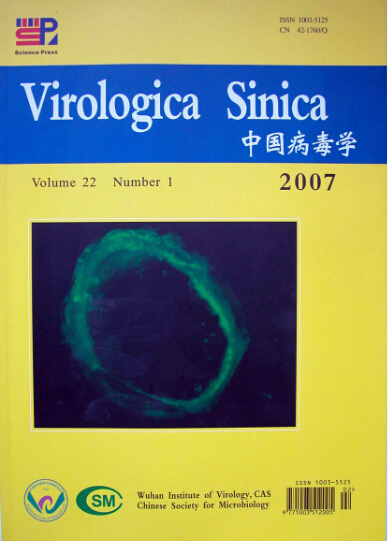Hong-bo FAN, Jun-wei LI, Zhi-lin LI, Wei ZHENG, Po Tien, De-yin GUO.Cloning of M and NP Gene of H5N1 Avian Influenza Virus and Immune Efficacy of their DNA Vaccines .VIROLOGICA SINICA, 2007, 22(1): 46-52.
Citation:
Hong-bo FAN, Jun-wei LI, Zhi-lin LI, Wei ZHENG, Po Tien, De-yin GUO.
Cloning of M and NP Gene of H5N1 Avian Influenza Virus and Immune Efficacy of their DNA Vaccines .VIROLOGICA SINICA, 2007, 22(1)
: 46-52.
Cloning of M and NP Gene of H5N1 Avian Influenza Virus and Immune Efficacy of their DNA Vaccines
-
Modern Virology Center,State Key Laboratory of Virology,College of Life Sciences,Wuhan University,Wuhan 430072,China
-
Corresponding author:
De-yin GUO, dguo@whu.edu.cn
-
Received Date:
30 August 2006
Accepted Date:
23 October 2006
Available online:
01 February 2007
Fund Project:
National Basic Science Talents Training Grant NSFC J0630648
-
Abstract
The M and NP gene of H5N1 avian influenza virus (A/chicken/Hubei/489/2004) were amplified by RT-PCR from viral RNA, and cloned into pMD18-T vector respectively. Then the expression plasmid containing M gene (pHM6-m) or NP gene (pHM6-np) was constructed by inserting M or NP gene into the pHM6 eukaryote expression vector, and sequenced. 32 BALB/c mice (6-week-old) were divided into four groups at random. Three groups of BALB/c mice were inoculated with 30 μg of plasmid pHM6-m, 30 μg of plasmid pHM6-np or the mixture of plasmid pHM6-m (15 μg ) and pHM6-np(15 μg) once via the intramuscular route respectively. A group of mice were injected with 100 μl PBS as controls. Two weeks later, all mice were challenged with homologous H5N1 avian influenza virus, and observed in the following 12 days. The survival rates of mice in pHM6-m group, pHM6-np group and mixed plasmids group were 62.5%, 25.0% and 50.0%, respectively. Results showed that effective protection could be provided by either pHM6-m or pHM6-np, but pHM6-m provided a better protective effect than pHM6-np.
-

-
-
References
-
Han Y,Wang X L. 2005. Immunomechanism and Optimized Strategies of DNA Vaccines[J]. J Med Mol Biol,2(2): 143-146.(in Chinese)
-
He H X,Qin X M,Zhang Q Z,et al. 2004. Cloning of HA Gene of H9N2 Subtype Avian Influenza Virus and Immune Protection Test of Its DNA Vaccine[J]. Prog Biochemi Biophy,31(2): 163-166.(in Chinese)
-
Hoffmann E,Stech J,Guan Y,et al. 2001. Universal primer set for the full-length amplification of all influenza A viruses[J]. Arch Virol,146(12): 2275-2289.
doi: 10.1007/s007050170002
-
Jiang Y P,Yu K Z,Deng G H,et al. 2004. Protection Effi-cacity of DNA Vaccine Encoding Hemagglutinin of H5 Subtype Avian Influenza Virus [J].Agricult Sci in China,37(7): 1071-1075.(in Chinese)
-
Jiang Y P,Zhang H B,LI C J,et al. 2005. Immunity Protection of H5 Subtype Avian Influenza DNA Vaccine pCAGGoptiHA5 from HPAIV Lethal Challenge[J]. Chin J Anim Veter Sci,36(11): 1178-1182.(in Chinese)
-
Lei C H,Chen J,Cui S J,et al. 2005. Cloning and sequence analysis of NS gene of H5N1 avian influenza virus strains from Xinjiang[J]. Chin J Veter Sci Technol,35(10): 779-785.(in Chinese)
-
Long J X,Wang Q Z,LU J H,et al. 2005. Cloning of full-length genes of H5N1 subtype Avian influenza virus strain A/duck/Shangdong/093/2004 and analysis of the sequences[J]. Acta Microbiologica Sinica,45(5): 690-696.(in Chinese)
-
Okuda K,Ihata A,Watabe S,et al. 2001. Protective immunity against influenza A virus induced by immunization with DNA plasmid containing influenza M gene[J]. Vaccine,19(27): 3681-3691.
doi: 10.1016/S0264-410X(01)00078-0
-
Zhang Q Z,Qin X M,Dong H L,et al. 2005. Efficient protection of H5N1 Influenza Virus DNA Vaccine Delivering by Electroporation in Mammalian and Avian System[J]. Prog Biochem Biophy,32(8): 726-733
-
Zhang R L,Peng C H,Rao H L. 2005. Research Progresses in DNA Vaccine[J]. Pract Clin Medic,6(10): 147-150.(in Chinese)
-
Zhao X M,Zhang Q Z,Duan M X,et al. 2005. Construction and Immune Assay of HA DNA Vaccine of H5N1 Subtype Avian Influenza Viruses[J]. Chin Agricult Sci Bull,21(5): 70-80.(in Chinese)
-
Proportional views

-












